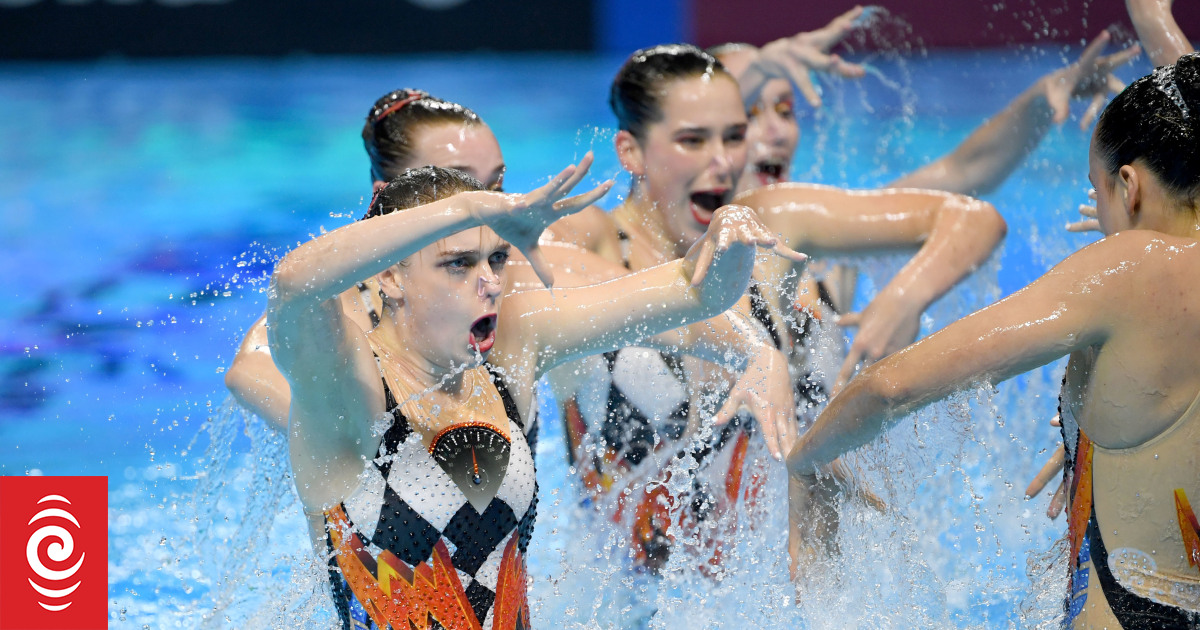Artistic Swimming NZ puts call out for boys and men
Artistic Swimming New Zealand wants to bust stigmas around the sport, formerly known as synchronised swimming, and get more boys and men to give it a go.

New Zealand compete in the Women’s Team Free event in Artistic Swimming (Synchro) at the 18th FINA World Swimming Championships in Gwangju, Korea on 17 July 2019.
Copyright photo: Delly Carr / www.photosport.nz
Photo: © Delly Carr 2019
The sport rebranded itself in 2017 after the world governing body FINA said the new name would better illustrate what the sport was about.
After decades of being seen as a women’s only sport, the International Swimming Federation (FINA) has also started opening up the sport to males.
The first loosening of the rules came in 2015 when men were able to compete at the World Aquatics Championships for the first time, in the mixed duets programme.
And just recently FINA voted in favour of allowing eight person team routines to include a maximum of two male competitors, a move it sees as part of its vision to maximise the global appeal of the sport.
That has led to speculation that the International Olympic Committee might consider allowing men to compete in the Paris 2024 Olympics.
Chair of Artistic Swimming New Zealand Shirley Hooper said either way the national body wanted to increase male participation.
“We’ve been probably a little bit slower on the uptake than many of the European countries. Men’s artistic swimming has been quite strong in particularly European countries, Russia, America,” Hooper said.
Hooper also happens to be the vice-president of World Netball.
“It’s a little bit like netball actually, where men have been involved in the sport for a long time but just not visible at the elite level. And these FINA changes now are opening up all sorts of possibilities for men in the sport, which is fantastic.”
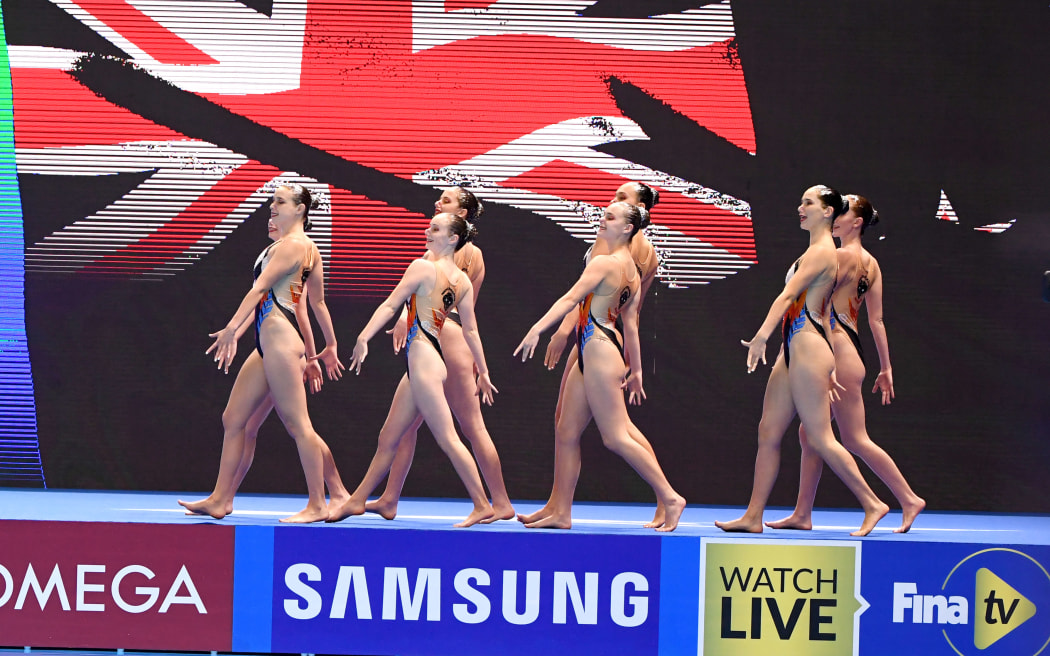
New Zealand compete in the Women’s Team Free event in Artistic Swimming (Synchro) at the 18th FINA World Swimming Championships in Gwangju, Korea on 17 July 2019.
Copyright photo: Delly Carr / www.photosport.nz
Photo: © Delly Carr 2019
Hooper said some people might have a mental block around the idea of men competing in artistic swimming but it was no different from men competing in figure skating.
And while it required grace, top competitors have to be insanely strong too.
Hooper said there were examples overseas where men, who had backgrounds in certain sports, had done really well in artistic swimming.
“If you look at gymnastics for example that would give you an advantage – take New Zealand trampolinist Dylan Schmidt (bronze medallist at the Tokyo Olympics) he’s got all sorts of skills that could transfer well.”
National bodies can set their own rules so boys have been competing in New Zealand for a long time, mostly in team routines.
Despite being very open to male participation, Hooper said it was difficult to build up numbers.
“It’s quite tough to be a minority in a sport and in New Zealand at every single event we always have one or two boys involved. It’s quite hard to forge the way unless you have a block of boys involved so that’s a big push for us in the coming year to get more boys, or men who have backgrounds in related sports trying it.
“It’s shoulder tapping, it’s getting out in our clubs, doing an active push to get boys involved, and trying to get more than say one boy involved in a club, getting a group of them involved as we try to build that part of our sport.”
Hooper said the perception that it was a girls’ activity was a barrier to boys enjoying what was actually a pretty cool sport.

Artistic Swimming New Zealand has been open to male participation for a long time.
Photo: Artistic Swimming New Zealand
She said it helped that FINA had opened its elite competitions up to men.
“That for us is the big one, the next one that we’re hoping to see is the Olympics – either Paris or the following Olympics that they’ll open the door to men in teams events particularly.
“I think if you see men involved on the international stage it makes it a very real pathway and that’s the greatest opportunity.”
Hooper believes men add a whole new dynamic to artistic swimming – think Torvill and Dean, the most famous figure skating duet to grace the Winter Olympics.
“What the men do is allow story telling in a different way in mixed duets. So you’ll often see them swimming to romantic music or to different forms of music so it allows them to tell a story through their routine.”
Kirstin Anderson competed in synchronised swimming for New Zealand at the Delhi 2010 Games with her sister Caitlin, the last time artistic swimming featured at a Commonwealth Games.
Anderson saw elite male artistic swimmers at international competitions throughout her career.
“Some competitions allowed them to enter even though it wasn’t in the rules, which was really cool so I knew American Bill May who is a pioneer in artistic swimming,” Anderson said.
She believes the sport could become more entertaining to outsiders with the inclusion of men.
“I think it would bring more height to lifts and maybe a bit more difficulty to the lifts as well. I just think it would take the sport on a whole new angle and be a great development.
“There’s some things that wouldn’t work with a female-female pair so it would be really cool to see men compete, there’s more creativity that can come by including the males.”
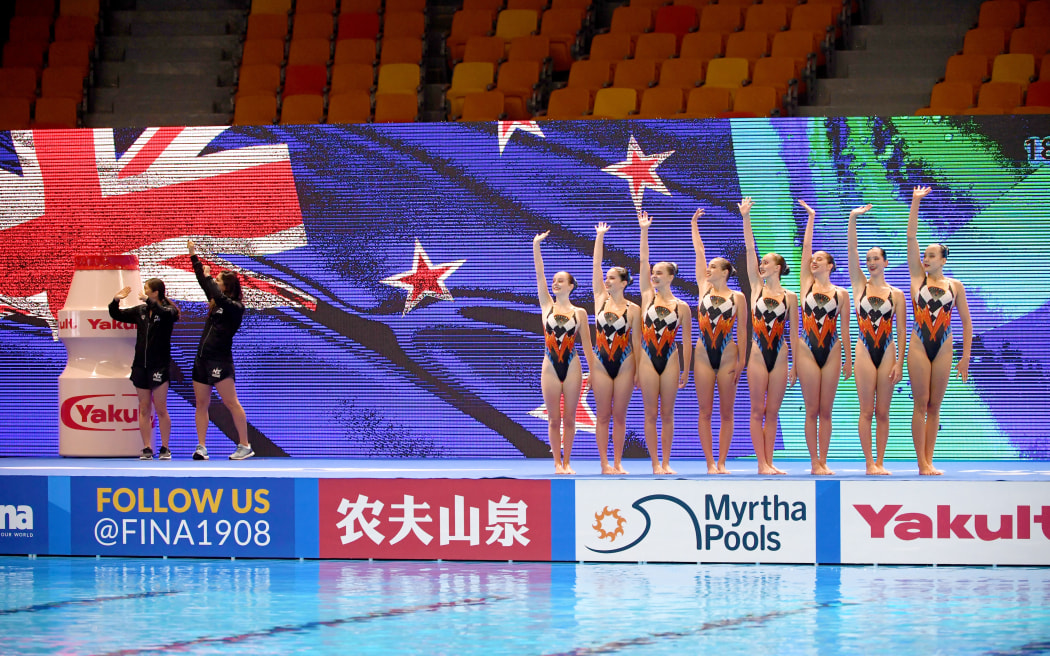
New Zealand compete in the Women’s Team Free event in Artistic Swimming (Synchro) at the 18th FINA World Swimming Championships in Gwangju, Korea on 17 July 2019.
Copyright photo: Delly Carr / www.photosport.nz
Photo: © Delly Carr 2019
Anderson has also done a lot of coaching and would love to see more males give it a go.
“In the last two years that I was coaching in Invercargill we had a wee boy competing. His sister did synchro and then his mum just put him in as well because they thought it was a really cool sport, so he competed the last two years just in a team event.
“If you’re starting later, males who have a background in gymnastics, swimming, diving, water polo, dance, acrobatics will have an advantage, it’s always going to be helpful.”
Artistic swimming has been an Olympic sport since 1984, but reserved for women.
New Zealand has been represented in the sport at the Olympics on just two occasions.
Katie Sadleir and sister Lynette competed in Los Angeles in 1984, then in 2008 another sister act – Lisa and Nina Daniels went to the Beijing Olympics.
Women compete in every category at the Olympics – though there remain two that are closed off to men – artistic swimming and rhythmic gymnastics.
The time could be right for artistic swimming, with the IOC wanting to achieve a 50 / 50 gender split at Paris 2024.
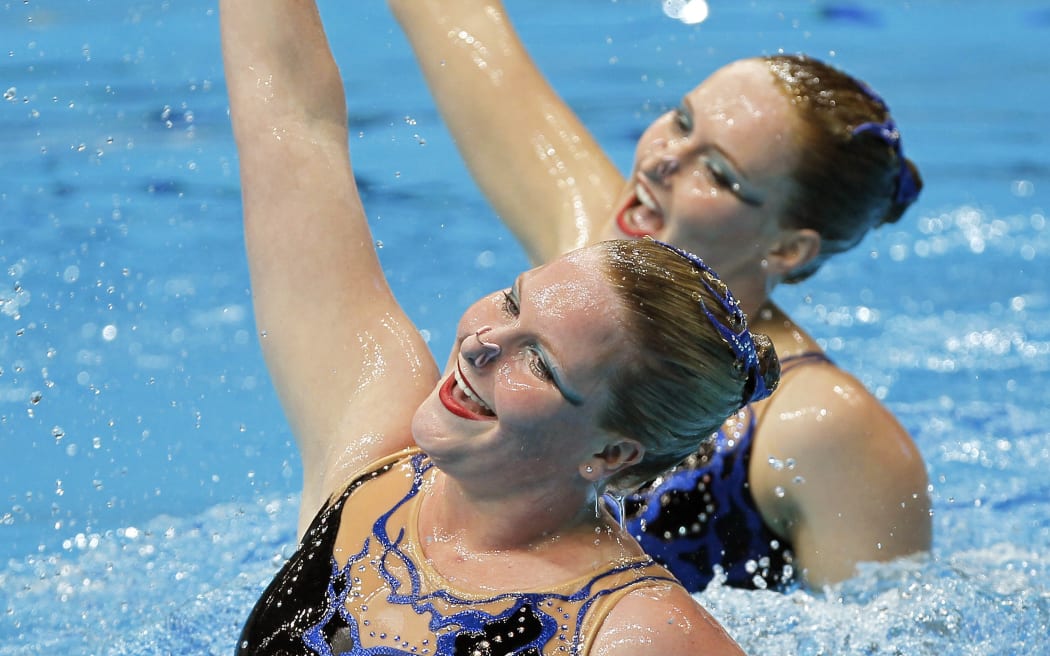
Caitlin and Kirstin Anderson during the Synchronised Swimming Duo routine. Commonwealth Games, New Delhi, 2010.
Photo: Simon Watts
Ayrton Sweeney competed in world championships and the Commonwealth Games in swimming for South Africa for 10 years before retiring last year.
Sweeney gave artistic swimming a go earlier this year by chance while he was in Cape Town.
“The first time I got in I thought okay this is a little bit ridiculous”, he laughs.
The 29-year-old said it was very physically demanding.
“Going into synchro I didn’t really understand. I thought it was more of a dance. I’m not saying that dance doesn’t use strength but for me in the water it didn’t seem like it would be a crazy challenge.
“I thought ‘okay I’m a strong guy I go to the gym my core is strong’. But when I got into that water and I had to start holding verticals upside down and different positions that I wasn’t used to it requires a lot of strength and I realised how hard it is.”
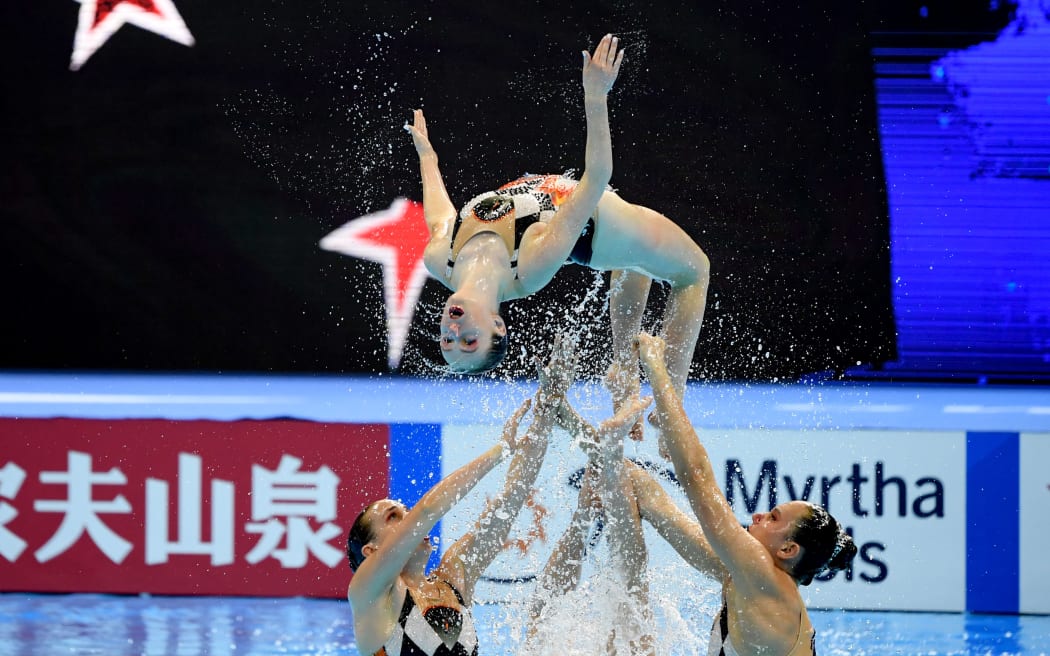
New Zealand compete in the Women’s Team Free event in Artistic Swimming (Synchro) at the 18th FINA World Swimming Championships in Gwangju, Korea on 17 July 2019.
Copyright photo: Delly Carr / www.photosport.nz
Photo: © Delly Carr 2019
Sweeney quickly grew an appreciation for the sport and it led to a conversation that there hadn’t been a male in South Africa compete internationally.
“That was a challenge for me, I had four months to qualify for World Champs in June with Laura [Strugnell] in the mixed duet and I said ‘okay let’s do this thing’. I didn’t ever think that I would get to World Champs to be honest, I knew it was a hard task but we made it.”
Sweeney admits he has his own stigmas about the sport, especially coming from the swimming world.
“I think swimmers in general don’t see synchro as a very difficult sport. We saw it as a beautiful, graceful sport which maybe didn’t require as much intensity but something I learned – if you look tired in your performance you can actually lose points, you have to resist the urge to gasp but force your face into a smile.”
Sweeney believes once men realise how much strength is needed, they will be attracted to the sport.
“You will get super shredded, the core muscles you need. the shoulder muscles, the legs everything …it’s crafting an amazing physique and I think once males know that too it’s a huge positive for the sport.”
Sweeney met some of the top male competitors at the World Champs in Budapest, who had spent years training for several hours a day.
He said they should be allowed to compete at the Olympics.
“Not being able to go to the Olympics to represent their country when they are phenomenal athletes – I actually don’t really understand how it hasn’t changed. I don’t know why men wouldn’t get the chance to showcase their abilities in a sport that they put their heart and soul into.”
For all the latest Sports News Click Here
For the latest news and updates, follow us on Google News.

